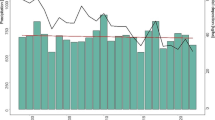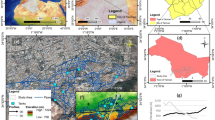Abstract
The determination of locations and sizes for such a system is important in a drainage master plan or a storm-water management system. However, the distribution of detentions in the upstream and midstream is often more dispersed using many combinations of volume scales. This paper uses the non-dominated sorting genetic algorithm combined with the Storm Water Management Model to explore and calculate the optimal layout scheme for decentralized rainwater detention. The purpose is to find a design and planning method that can achieve the optimal balance of decentralized detention considering the aspects of flood disaster control, peak flow reduction, and investment cost. The optimal results of Pareto in applied case show that among the five most unfavourable nodes, the detentions with different layout volumes and relatively smaller size can control water logging from rainstorm. The project cost is effectively reduced and the standard of the return period of the regional rainwater system is enhanced from 2 to 20 years.








Similar content being viewed by others
References
Behera PK, Papa F, Adams BJ (1999) Optimization of regional storm-water management systems. Journal of Water Resource Planning and Management 125(2):107–114
Brummer J (1995) A constructive solution for optimal local control of runoff events. Math Comput Simul 39(1):39–52
Cembrano G, Quevedo J, Salamero M, Puig V, Figueras J, MartÍ J (2004) Optimal control of urban drainage systems. A case study. Control Eng Pract 12(1):1–9
Deb K, Pratap A, Agarwal S, Meyarivan T (2002) A fast and elitist multiobjective genetic algorithm: Nsga-Ii. Evolutionary computation. IEEE Trans 6(2):182–197
Engeland Kolbjørn, Braud Isabelle, Gottschalk Lars, Leblois Etienne (2006) Multi-objective regional modelling. J Hydrol 327(3–4):339–351
Fu Guangtao, Butler David, Khu Soon-Thiam (2008) Multiple objective optimal control of integrated urban wastewater systems. Environ Model Softw 23(2):225–234
Gottschalk Lars, Weingartner Rolf (1998) Distribution of peak flow derived from a distribution of rainfall volume and runoff coefficient, and a unit hydrograph. J Hydrol 208(3–4):148–162
Guillemette François, Plamondon André P, Prévost Marcel, Lévesque Denis (2005) Rainfall generated stormflow response to clearcutting a boreal forest: peak flow comparison with 50 world-wide basin studies. J Hydrol 302(1–4):137–153
Gumbo Bekithemba, Munyamba Nelson, Sithole George, Savenije HHG (2002) Coupling of digital elevation model and rainfall-runoff model in storm drainage network design. Phys Chem Earth, Parts A/B/C 27(11–22):755–764
Hong Yao-Ming (2010) Experimental evaluation of design methods for in-site detention ponds. Int J Sedim Res 25(1):52–63
Iqbal Jawed, Guria Chandan (2009) Optimization of an operating domestic wastewater treatment plant using elitist non-dominated sorting genetic algorithm. Chem Eng Res Des 87(11):1481–1496
Kaini P, Artita K, Nicklow JW (2007) Evaluating optimal detention pond locations at a watershed scale. World environmental and water resources congress 2007: restoring our natural habitat, 2007 ASCE
Kibler DF, Froelich CD, Aron G (2007) Analyzing urbanization impacts on Pennsylvania flood peaks. J Am Water Resour Assoc 17(2):270–274
Kowalski R, Reuber J, Köngeter J (1999) Investigations into and optimisation of the performance of sewage detention tanks during storm rainfall events. Water Sci Technol 39(2):43–52
Lee Jae Su, Li Ming-Han (2009) The impact of detention basin design on residential property value: case studies using gis in the hedonic price modeling. Landsc Urban Plan 89(1–2):7–16
Lessard P, Beck MB (1991) Dynamic simulation of storm tanks. Water Res 25(4):375–391
Mays LW, Bedient PB (1982) Model for optimal size and location of detention. J Water Resour Plann Manage 108(3):270–285
Nadarajah Saralees, Kotz Samuel (2007) Exact distribution of the peak runoff. J Hydrol 338(3–4):325–327
Nirupama N, Simonovic SP (2007) Increase of flood risk due to urbanization: a Canadian example. Nat Hazards 40:25–41
Papa Fabian, Adams Barry J (1997) Application of derived probability and dynamic programming techniques to planning regional stormwater management systems. Water Sci Technol 36(5):227–234
Persson J (2000) The hydraulic performance of ponds of various layouts. Urban Water 2(3):243–250
Persson J, Somes NLG, Wong THF (1999) Hydraulics efficiency of constructed wetlands and ponds. Water Sci Technol 40(3):291–300
Rathnam EV, Mahammad Abdulla S, Jayakumar KV (2002) Urban runoff estimation and optimization of stormwater detention systems-a case study for Hyderabad city. India, Urban Drainage
Rié Komuro E, Ford David, Reynolds Joel H (2006) The use of multi-criteria assessment in developing a process model. Ecol Model 197(3–4):320–330
LA Rossman (2004) Storm water management model user’s manual (Version 5.0)
Scholz Miklas (2004) Case study: design, operation, maintenance and water quality management of sustainable storm water ponds for roof runoff. Bioresour Technol 95(3):269–279
Segarra Rafael I (1995) Optimal design of runoff storage/release systems. Water Sci Technol 32(1):193–199
Sim Low Kwai, Balamurugan G (1991) Urbanization and urban water problems in southeast Asia a case of unsustainable development. J Environ Manage 32(3):195–209
Suhyung J, Minock C (2007) Using SWMM as a tool for hydrologic impact assessment. Desalination 212:344–356
Travis Quentin B, Mays Larry W (2008) Optimizing retention basin networks. J Water Resour Plann Manage 134(5):432–439
Xiang S, Griffiths John F (1988) A survey of agrometeorological disasters in south China. Agric For Meteorol 43(3–4):261–276
Yeh CH, Labadie JW (1997) Multiobjective watershed-level planning of storm water detention systems. J Water Resour Plann Manage 123(6):336–343
Yuan Lin, Zhang Liquan, Xiao Derong, Huang Huamei (2011) The application of cutting plus waterlogging to control spartina alterniflora On Saltmarshes in the Yangtze estuary, China. Estuar Coast Shelf Sci 92(1):103–110
Zhen X-Y, Yu S-L, Lin J-Y (2004) Optimal location and sizing of stormwater basins at watershed scale. J Water Resour Plann Manage 130(4):339–347
Acknowledgments
Funding support from The Major Science and Technology Project-Water Pollution Control and Treatment (No. 2009ZX07317-008).
Author information
Authors and Affiliations
Corresponding author
Rights and permissions
About this article
Cite this article
Tao, T., Wang, J., Xin, K. et al. Multi-objective optimal layout of distributed storm-water detention. Int. J. Environ. Sci. Technol. 11, 1473–1480 (2014). https://doi.org/10.1007/s13762-013-0330-0
Received:
Revised:
Accepted:
Published:
Issue Date:
DOI: https://doi.org/10.1007/s13762-013-0330-0




